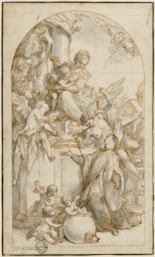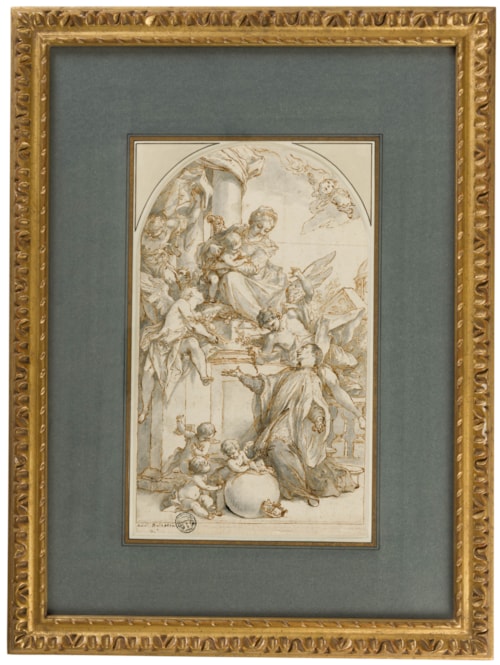Antonio BALESTRA
(Verona 1666 - Verona 1740)
The Virgin and Child Adored by Saint Aloysius Gonzaga
Sold
Pen and brown ink and grey wash, over an underdrawing in black chalk, with framing lines in brown ink. Laid down.
Inscribed Anto Balestra in the lower right margin.
270 x 151 mm. (10 5/8 x 6 in.) [image]
290 x 174 mm. (11 3/8 x 6 7/8 in.) [sheet]
Inscribed Anto Balestra in the lower right margin.
270 x 151 mm. (10 5/8 x 6 in.) [image]
290 x 174 mm. (11 3/8 x 6 7/8 in.) [sheet]
Relatively few drawings by Balestra are known today, and of these only a handful can be related to finished paintings by the artist. The present sheet is a preparatory compositional study, with several significant differences, for the artist’s painting of The Virgin and Child with Saint Aloysius Gonzagaon the high altar of the Sanctuary of San Luigi Gonzaga in Castiglione delle Stiviere, in the province of Mantua in Lombardy. (The town was the birthplace of the 16th century Jesuit saint Aloysius (Luigi) Gonzaga, who was born into a cadet branch of the noble Gonzaga family in 1568 and died at the age of twenty-three.) The Castiglione delle Stiviere altarpiece is mentioned in Balestra’s manuscript autobiography (‘Una Tavola d’Altare alli P.P. Gesuiti di Castiglione con la B.V. e S. Luigi Gonzaga’) as having been executed in 1734. In the altarpiece, the influence of 16th century compositional prototypes established by Paolo Veronese is combined with a Baroque classicism derived from the example of Maratti. As Andrew Robison has described the altarpiece, ‘[Balestra] conceived it in a very traditional Venetian manner: the Virgin and Child enthroned on a plinth, high on the left, set against two columns open to the air, with Saint Luigi Gonzaga kneeling on the right, looking up and praying to the Virgin.’ An oil sketch related to the Castiglione delle Stiviere painting was in the Caprioli collection in Mantua in 1968.
The Balestra scholar Andrea Tomezzoli has noted of this fine drawing that, ‘in the transition from paper to canvas, there seems to be greater self-control, a more markedly ‘classicizing’ spirit that prizes gestures in calmer, more composed forms...The lively, sparkling, barochetto vivacity [of the drawing] has been sacrificed in the name of a more marked solemnity.’ While the present sheet is a undoubtedly study for the Castiglione delle Stiviere altarpiece, its degree of finish has led some scholars to suggest that it may have been intended either as a presentation drawing to be shown to the patron of the painting, or as a finished, independent work of art in its own right, to be sold to a collector.
The same year that Balestra painted The Virgin and Child Adored by Saint Aloysius Gonzaga for Castiglione delle Stiviere, he received his first commission for a major painting for a Roman church; a Virgin and Child with Saints Gregory the Great and Andrew for the high altar of San Gregorio al Celio, completed in 1735. The artist’s initial idea for that composition, represented by a drawing in a private collection in Washington, D.C., was derived from the Castiglione delle Stiviere altarpiece. Both the Washington drawing and a much larger and more finished study for the same San Gregorio al Celio commission, now in the collection of the National Gallery of Art in Washington, D.C., are stylistically comparable with the present sheet.
Other depictions of Saint Aloysius Gonzaga by Balestra appear in a much earlier altarpiece of The Virgin and Child with Three Saints of 1704 in the Venetian church of Santa Maria Assunta, better known as the Gesuiti, as well as in a later painted standard, executed in 1727, which is now in the Museo di Castelvecchio in Verona.
The distinctive collector’s mark stamped at the bottom of this sheet is found on a number of Italian drawings dating from the 15th to the 18th centuries. The mark had at one time been thought to be that of Prince Henry of Bourbon-Parma, Count of Bardi (1851-1905), who resided at the Ca’ Vendramin Calergi in Venice, but this remains hypothetical. The same mark appears on drawings by or attributed to Giovanni Benedetto Castiglione, Francesco Fontebasso, Johann Carl Loth, Giambattista Piazzetta, Pietro Rotari, Andrea Schiavone and Giambattista Tiepolo.
The Balestra scholar Andrea Tomezzoli has noted of this fine drawing that, ‘in the transition from paper to canvas, there seems to be greater self-control, a more markedly ‘classicizing’ spirit that prizes gestures in calmer, more composed forms...The lively, sparkling, barochetto vivacity [of the drawing] has been sacrificed in the name of a more marked solemnity.’ While the present sheet is a undoubtedly study for the Castiglione delle Stiviere altarpiece, its degree of finish has led some scholars to suggest that it may have been intended either as a presentation drawing to be shown to the patron of the painting, or as a finished, independent work of art in its own right, to be sold to a collector.
The same year that Balestra painted The Virgin and Child Adored by Saint Aloysius Gonzaga for Castiglione delle Stiviere, he received his first commission for a major painting for a Roman church; a Virgin and Child with Saints Gregory the Great and Andrew for the high altar of San Gregorio al Celio, completed in 1735. The artist’s initial idea for that composition, represented by a drawing in a private collection in Washington, D.C., was derived from the Castiglione delle Stiviere altarpiece. Both the Washington drawing and a much larger and more finished study for the same San Gregorio al Celio commission, now in the collection of the National Gallery of Art in Washington, D.C., are stylistically comparable with the present sheet.
Other depictions of Saint Aloysius Gonzaga by Balestra appear in a much earlier altarpiece of The Virgin and Child with Three Saints of 1704 in the Venetian church of Santa Maria Assunta, better known as the Gesuiti, as well as in a later painted standard, executed in 1727, which is now in the Museo di Castelvecchio in Verona.
The distinctive collector’s mark stamped at the bottom of this sheet is found on a number of Italian drawings dating from the 15th to the 18th centuries. The mark had at one time been thought to be that of Prince Henry of Bourbon-Parma, Count of Bardi (1851-1905), who resided at the Ca’ Vendramin Calergi in Venice, but this remains hypothetical. The same mark appears on drawings by or attributed to Giovanni Benedetto Castiglione, Francesco Fontebasso, Johann Carl Loth, Giambattista Piazzetta, Pietro Rotari, Andrea Schiavone and Giambattista Tiepolo.
The son of a wealthy merchant in Verona, Antonio Balestra was trained in the Venetian studio of Antonio Bellucci from 1687, and completed his studies with Carlo Maratti in Rome, where he settled around 1690. His time in Maratti’s studio was of particular importance in the development of his later style. In 1694 he won first prize in a drawing competition at the Roman Accademia di San Luca with a drawing of The Fall of the Giants. After a brief period in Naples, Balestra returned to the north of Italy and spent the remainder of his career working mainly between Venice and his native Verona, where one of his first important paintings was an Annunciation for the church of the Scalzi, executed in 1697. Balestra painted easel pictures for private clients and larger works for local churches in the Veneto and Lombardy, his canvases displaying a synthesis of the classical style of the Roman, Bolognese and Neapolitan Baroque traditions with Venetian colouring. Many of his paintings were reproduced as engravings, which spread his fame beyond the Veneto - to Tuscany, Lombardy and Germany - while he also produced a number of etchings himself. Balestra worked mainly in Venice between 1700 and 1718, but by 1719 had settled for good in Verona. His patrons included the Marchese Scipione Maffei, who also encouraged the artist to produce book illustrations. Among his final significant works were an extensive series of frescoes of scenes from the Aeneid for the main hall of the Villa Pompei Carlotti at Illasi, near Verona, painted in 1738. A distinguished teacher, Balestra opened an academy of life drawing from the nude and trained several fine pupils and followers, notably Giuseppe Nogari and Pietro Longhi in Venice and Giambettino Cignaroli and Pietro Rotari in Verona.
Provenance
An unidentified collector’s mark (Lugt 336), formerly identified as that of Henry of Bourbon-Parma, Count of Bardi, Venice
Anonymous sale, London, Christie’s, 6 July 1999, lot 64
Flavia Ormond, London
Private collection.
Anonymous sale, London, Christie’s, 6 July 1999, lot 64
Flavia Ormond, London
Private collection.
Literature
Andrea Tomezzoli, Tasselli per la grafica veronese del Settecento, Arte Veneta, 2007, pp.220-221, fig.11 (as location unknown); Giorgio Marini, Un percorso per Balestra disegnatore, in Andrea Tomezzoli, ed., Antonio Balestra: Nel segno della grazia, exhibition catalogue, Verona, 2016-2017, p.99, fig.43 (as location unknown); Denis Ton, Balestra e i Gesuiti, in Tomezzoli, ed., ibid., p.62.
Exhibition
Stanford University, Cantor Center for Visual Arts, Classic Taste: Drawings and Decorative Arts from the Collection of Horace Brock, March-May, 2000.





